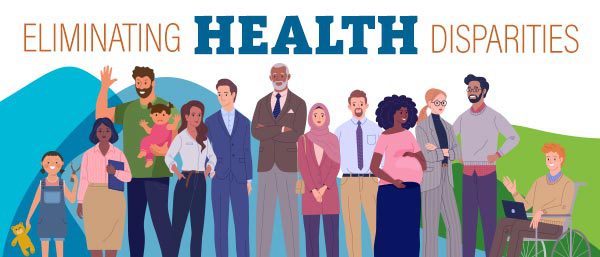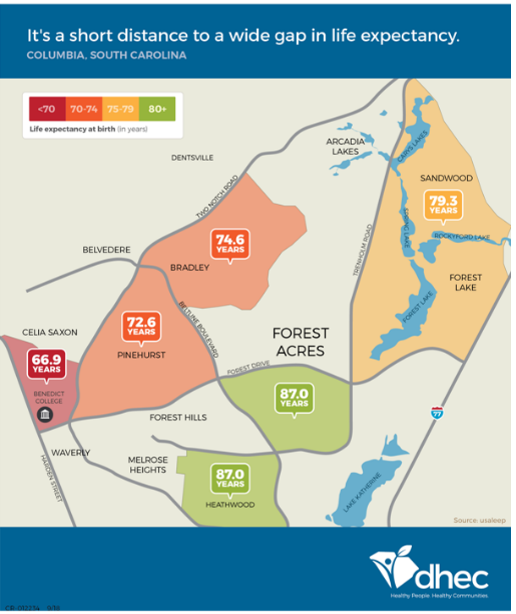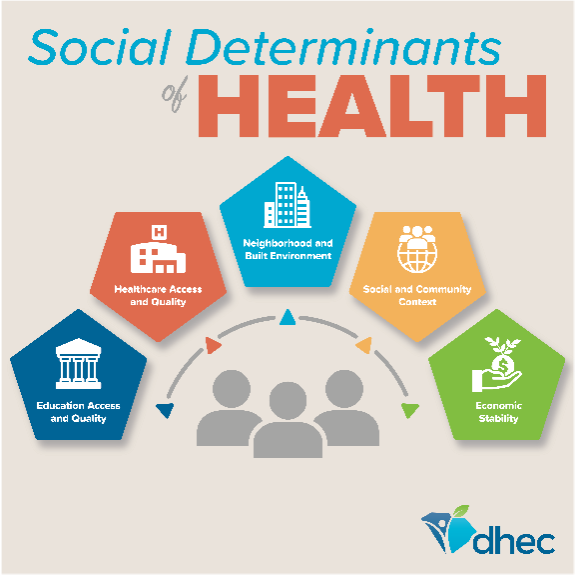
Community-Driven Solutions to Ensure a Healthier Future for Everyone
At DHEC, we recognize that where we live impacts our health and the health of our communities, and we are committed to working with our partners to make our communities healthier, stronger, and safer for everyone. That’s why we are focused on increasing awareness of the important work being done in our communities to eliminate health disparities.
DHEC is uniting with our many partners and community members across the state to overcome health disparities and realize the goal of every individual having the opportunity to achieve their full health potential. This includes a more focused involvement with residents and grass roots organizations.
On this page you will find information about existing differences in health outcomes across our state and how DHEC and others are working to address them.
Differences in Health Outcomes Result from Unfair Practices and Other Factors
A growing body of research shows that social determinants of health—such as access to quality health care, education, social connectedness, healthy food, housing, wealth, and employment—play a key role in health inequities within our communities. People in communities lacking access to these factors are at great risk of not only poor health outcomes, but poor outcomes in life. Addressing these social determinants is a vital part of health and healthcare.
What Are Social Determinants of Health?
Social Determinants of Health (SDOH) are conditions in the places where people live, learn, work, and play that affect a wide range of health risks and outcomes. Healthy People 2030 outlines five key areas of SDOH:
Healthcare access and quality
The connections between people’s access to and understanding of health services and their own health. This includes key issues such as access to healthcare, primary care, and insurance coverage, as well as health literacy.
Education Access and Quality
The connection of education to health and wellbeing, including issues such as graduating from high school, enrollment in higher education, educational attainment in general, language and literacy, and early childhood education and development.
Social and Community Context
The connection between the contexts within which people, live, learn, work, and play, and their health and wellbeing. This includes topics like cohesion within a community, social connectedness, civic participation, discriminatory policies, conditions in the workplace, and incarceration.
Economic Stability
The connection between the financial resources people have, such as income, cost of living, and socioeconomic status, and their health. This includes key issues such as poverty, employment, food security, and housing stability.
Neighborhood and Built Environment
The connection between where a person lives, such as their housing, neighborhood, and environment, and their wellbeing. This includes their quality of housing, access to transportation, availability of healthy foods, air and water, and neighborhood crime and violence.
The Cost of Disparities on the Health of South Carolina Communities
Specifically, ongoing inequities in the determinants of health lead to lasting negative health outcomes for communities of color. Data show that racial and ethnic minorities across South Carolina and the US experience higher rates of illness and death from conditions such as diabetes, obesity, asthma, and heart disease, when compared to their White counterparts. Also, CDC data show that the life expectancy of non-Hispanic/Black Americans is six years lower than that of White Americans.

Today in South Carolina, African American women are significantly more likely to suffer adverse outcomes during pregnancy and childbirth, and their children are more likely to die in the first year of life. In addition, as noted by First Steps, African American and Hispanic children are much less likely to be ready for first grade than their White peers. Further, those in a lower socioeconomic status have worse outcomes across a number of health indicators.
While South Carolina continues to prosper and is home to very affluent areas across the state, there are also impoverished areas. Recent public health data shows that depending on what part of a county you live in, the health conditions of your community may be dramatically different. For example, if you look at a census track of Columbia, you’ll find that there is a 20-year difference in life expectancy for individuals living not even a half a mile apart. In addition, from 2016 to 2020, roughly 10 out of every 10,000 residents of the 29203 ZIP Code in Columbia underwent an amputation of part of their leg or foot. This represents one of the highest amputation rates due to diabetes in the nation and nearly two times higher than the state rate.
Differences in life expectancies are also seen when it comes to gender. In 2019, males in South Carolina saw a 2.7 times higher rate of injury deaths when compared to their female counterparts. They were also 4.5 higher rate of suicide and 2.1 times higher rate of total drug overdose mortality when compared to females.
Improving the health and well-being of those impacted by health disparities protects and improves the long-term health and prosperity of our entire state, including improving quality of life for all South Carolinians and controlling costs of preventable chronic disease. According to the CDC, 90 percent of the nation’s $3.8 trillion in annual health care expenditures are for people with chronic and mental health conditions. Investing in the prevention of chronic diseases or managing symptoms can not only save lives, but it can reduce costs.
This necessary work will take time but will bring meaningful change in the health of South Carolinians. These disparities developed over a long period of time due to long-standing policies that left a significant portion of our population sicker, poorer, and more vulnerable to illnesses and diseases. This work will not be easy, but we must undertake this effort to improve the health of everyone in our state.
Statewide Efforts to Improve Health Outcomes
DHEC’s various divisions and programs are working with partners to address health inequities across our state. Some of that work includes efforts to reduce infant and maternal mortality, promote quality care for those who require nursing care and related medical services, ensure women have access to age-appropriate breast and cervical cancer screening and follow up, and mitigate the environmental impact of hurricanes and other disasters on local communities. DHEC’s Public Health (PH) division also has established an Office of Diversity, Equity, and Inclusion (DEI). PH’s DEI Office provides knowledge, skills, resources, and technical assistance to support efforts to promote an inclusive and equitable environment and services that value and leverage the diversity of all Public Health staff, partners, and South Carolina communities.
Community Partners in Action: South Carolina’s COVID-19 Vaccine Rollout Efforts
A recent example of how the coordination between state and community partners has helped to address existing disparities is the state’s COVID-19 vaccination efforts. Early in the pandemic local and national data show that African Americans and other minority populations were not only disproportionately impacted by this disease, but also had lower rates of vaccination against COVID-19. Specifically, in March 2021, the Black and Hispanic populations had lower vaccination rates when compared to the White population (7% and 11% lower, respectively).
Recognizing that this was a critical issue, DHEC, working with external partners like the NAACP the AME Church, Latinx media outlets, and other faith-based and community service organizations focused on resolving this disparity. The result of these efforts are African Americans and Hispanics are, as of April 8, 2022, more likely to be vaccinated than other groups in South Carolina. This example shows that when we work with our partners, we can successfully address the health disparities in our state.
Our Path Forward
DHEC will continue its work to address the social determinants of health and advance health equity in partnership with community leaders and organizations across the state. This includes:
- Increasing awareness of disparities and the social determinants of health.
- Improving access to actionable, community-level public health data.
- Working with community members and organizations to provide resources and information to develop sustainable solutions that work for their community.
- Engaging communities in a way that allows them to express their needs and learn about the issues that matter to them, so that DHEC and our many partners continue to be responsive to their concerns.
- Ensure efforts include a focus on expecting parents, infants, and children, to support healthier head starts early in life.
- Educating and information about policies through a health equity lens.
Fast Facts and Resources
|
Community Data Walk Posters |
SC Chronic Diseases and Injury Data | Health Equity Resources from Alliance SC |
Health Equity Dashboard
To enhance community access to actionable public health data, DHEC is developing a health equity dashboard. The dashboard will provide the public with selected data at the county-level surrounding health disparities in their communities. We will share details about the dashboard's launch once available.
